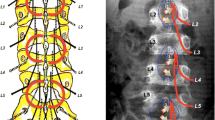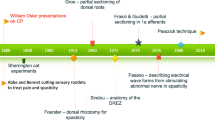Abstract
Although selective posterior rhizotomy (SPR) was pioneered as early as 1913, only over the past decade has the procedure gained popular use for the treatment of spasticity in cerebral palsy. The medical knowledge base regarding this procedure is expanding, and surgical techniques continue to be revised. We present our 7 years of experience in treating spastic cerebral palsy using SPR. The aspects of preoperative evaluation used by the multidisciplinary team to determine candidacy are outlined. The surgical procedure is detailed with a particular emphasis on the role of intraoperative nerve root stimulation to aid in selection for rootlet sectioning. Historical nerve stimulation protocols are reviewed and compared to our findings over the years. The functional goals are discussed in the context of the postoperative evaluation and therapies. Specific outcome in relation to joint range of motion, self care tasks, and ambulation is reported. The paper outlines a concise overview of our experiences and will assist the clinician in defining a protocol and expectations for SPR.
Similar content being viewed by others
References
Abbott R, Forem SL, Johann M (1989) Selective posterior rhizotomy for the treatment of spasticity: review. Child's Nerv Syst 5:337–346
Abbott R, Deletes V, Spielholz N, Wisoff JH, Epstein FJ (1990) Selective posterior rhizotomy: pitfalls in monitoring. Concepts Pediatr Neurosurg 10:187–195
Albright AL (1989) Selective posterior rhizotomies for spasticity in children. J Prosthet Orthop 2:54–58
Cahan LD, Adams JM, Perry J, Beeler L (1990) Instrumented gait analysis after selective dorsal rhizotomy. Dev Med Child Neurol 32:1037–1043
Cohen AR, Webster HC (1991) How selective is selective posterior rhizotomy? Surg Neurol 35:267–272
Cole HM (ed) (1990) Diagnostic and therapeutic technology assessment (DATTA). JAMA 264:2569–2574
DeCandia M, Provini L, Taborikova H (1967) Mechanisms of the reflex discharge depression in the spinal motoneuron during repetitive orthodromic stimulation. Brain Res 4:284–291
Dudgeon BJ, Libby AK, McLaughlin JF, Hays RM, Bjornson KF, Roberts TS (1994) Prospective measurement of functional changes after selective dorsal rhizotomy. Arch Phys Med Rehabil 75:46–53
Fasano VA, Broggi G, Barolat-Romana G, Sguazzi A (1978) Surgical treatment of spasticity in cerebral palsy. Child's Brain 4:289–305
Fasano VA, Barolat-Romana G, Zemes S, Squazzi A (1979) Electrophysiological assessment of spinal circuits in spasticity by direct dorsal root stimulation. Neurosurgery 4:146–151
Fasano VA, Broggi G, Zemes S (1988) Intraoperative electrical stimulation for functional posterior rhizotomy. Scand J Rehabil Med [Suppl] 17:149–154
Foerster O (1913) On the indications and results of the excision of posterior spinal nerve roots in men. Surg Gynecol Obstet 16:463–474
Futagi Y, Abe J (1985) H-reflex study in normal children and patients with cerebral palsy. Brain Dev 7:414–420
Futagi Y, Abe J Tanaka J, Okamoto N, Ikoma H (1988) Recovery curve of the H-reflex in normal infants, central coordination disturbance cases and cerebral palsy patients within the first year of life. Brain Dev 10:8–12
Harper CM, Nelson KR (1992) Intraoperative electrophysiological monitoring in children. J Clin Neurophysiol 9:342–351
Landau WM, Hunt CC (1990) Dorsal rhizotomy, a treatment of unproven efficacy. J Child Neurol 5:174–178
Magladery JW, Teasdall RD, Park M, Languth HW (1952) Electrophysiological studies of reflex activity in patients with lesions of the nervous system. I. A comparison of spinal motoncurone excitability following afferent nerve volleys in normal persons and patients with upper motor neurone lesions. Bull Johns Hopkins Hosp 91:219–244
Mayer RF, Mosser RS (1969) Excitability of motoneurons in infants. Neurology 19:932–945
Molnar GF (1985) Cerebral palsy. In: Molnar GF (ed) Pediatric rehabilitation. Williams & Wilkins, Baltimore, pp 420–467
Nelson KR, Phillips LH (1990) Neurophysiologic monitoring during surgery of peripheral and cranial nerves and in selective dorsal rhizotomy. Semin Neurol 10:141–149
Park TS, Owen JH (1992). Surgical management of spastic diplegia in cerebral palsy. N Engl J Med 326:745–749
Peacock WJ, Arens LJ (1982) Selective posterior rhizotomy for the relief of spasticity in cerebral palsy. S Afr Med J 62:119–124
Peacock WJ, Staudt LA (1990) Spasticity in cerebral palsy and selective posterior rhizotomy procedure. J Child Neurol 5:179–185
Phillips LH, Park TS (1989) Electrophysiologic studies of selective posterior rhizotomy patients. In: Park TS, et al (eds) Management of spasticity in cerebral palsy and spinal cord injury. Neurosurgery: state of the art reviews. Hanley and Belfus, Philadelphia, pp 459–469
Staudt LA, Peacock WJ (1989) Selective posterior rhizotomy for treatment cerebral palsy. Pediatr Phys Ther 1:3–9
Taborikova H, Sax DS (1969) Conditioning of H-reflexes by a preceding subthreshold H reflex stimulus. Brain 92:203–212
Uniform Data System (1990) Guide to the use of the pediatric functional independence measure. Research Foundation, State University of New York, Buffalo
Vaughn CL, Berman B, Staudt LA, et al (1988) Gait analysis of cerebral palsy children before and after rhizotomy. Pediatr Neurosci 14:297–300
Weiss IP, Schiff SJ (1993) Reflex variability in selective dorsal rhizotomy. J Neurosurg 346–353
Author information
Authors and Affiliations
Rights and permissions
About this article
Cite this article
Nishida, T., Thatcher, S.W. & Marty, G.R. Selective posterior rhizotomy for children with cerebral palsy: a 7-year experience. Child's Nerv Syst 11, 374–380 (1995). https://doi.org/10.1007/BF00717399
Received:
Revised:
Issue Date:
DOI: https://doi.org/10.1007/BF00717399




